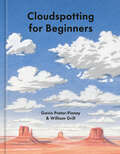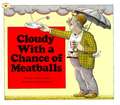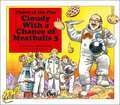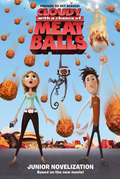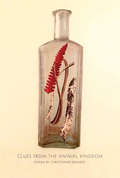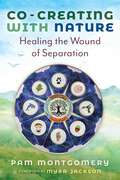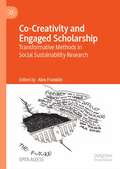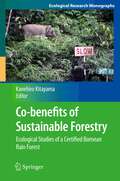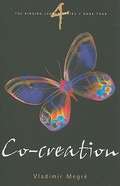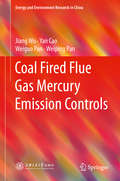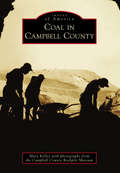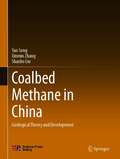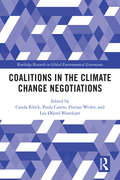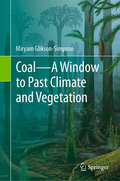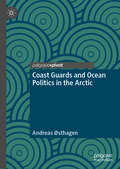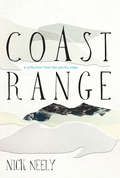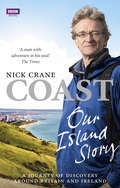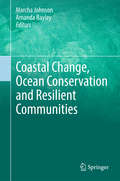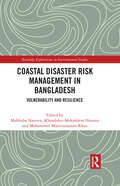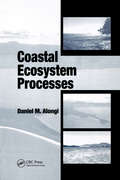- Table View
- List View
Clouds (Let's Read and Find Out Science)
by Anne Rockwell Frané LessacDo you ever wake up and wonder what the weather will be? Instead of turning on the TV to find out, you can just look out your window at the clouds. How do you know what type of clouds can forecast a change of weather? Read and find out.
Cloudspotting for Beginners
by Gavin Pretor-Pinney William GrillA beautifully illustrated guide to clouds and the sky for inspiring and educating curious minds with meteorological wonder.Renowned journalist, public speaker, and founder of the Cloud Appreciation Society Gavin Pretor-Pinney details the key facts and characteristics about each major cloud type. To accompany these scientific tidbits, William Grill&’s gorgeous illustrations of vast colorful skies and mesmerizing cloud patterns create a calming, thought-provoking learning experience.From low-lying Stratus to high-flying Cirrus, Cloudspotting for Beginners covers how clouds are formed, the altitudes they prefer, the curious shapes they take, how they affect other meterological events, and more. The book breaks down the life and structure of a cloud on a molecular level, and then even expands on their interesting cross-planetary variations—for example, Jupiter&’s clouds are composed of ammonia ice crystals and Saturn&’s clouds congregate in an inexplicable hexagon around the planet's North Pole.Clouds require a fascinating amount of chemical precision in order to exist, yet they disappear and form again on a daily basis with ease. Cloudspotting for Beginners is a whimsical lesson on the oft-overlooked extraordinary lives of clouds that will serve as a gentle reminder to be present and observant in the face of impermanence. Just as informative as it is poetic and peaceful, this is the perfect guide for cloud appreciators and sky lovers.
Cloudy With a Chance of Meatballs
by Judi Barrett Ron BarrettLife is delicious in the town of Chewandswallow where it rains soup and juice, snows mashed potatoes, and blows storms of hamburgers--until the weather takes a turn for the worse. Images and image descriptions available.
Cloudy With a Chance of Meatballs 3: Planet of the Pies
by Judi BarrettWhen astronauts land on Mars, their first discovery is a substance not unlike pie filling, and Kate and Henry are eager to go taste some, but Grandpa, who may have some inside information, discourages them.
Cloudy with a Chance of Meatballs (Junior Novelization)
by Stacia Deutsch Rhody CohonFlint Lockwood is an eccentric young scientist whose awkward demeanor and half-baked inventions (ratbirds, spray-on shoes, and talking monkeys) have made him an outsider in his hometown of ChewandSwallow. All that is about to change with his latest contraption, a miraculous food-making machine. His creation brings happiness to the town, but when things go awry, the forecast for the whole world quickly changes from sunny to Cloudy with a Chance of Meatballs!
Clues from the Animal Kingdom (American Poets Continuum #167)
by Christopher KennedyIn his fifth collection of poems, Christopher Kennedy sifts through the detritus of the past to uncover the memories, images, and symbols that shape an individual’s consciousness. Looking to animals and their instincts for inspiration, drawing shape from the poet’s Irish Catholic working-class roots, these prose poems transcend grief and depression by seeking humanity’s place in the natural world.
Co-Creating with Nature: Healing the Wound of Separation
by Pam Montgomery• Establishes that being in partnership with Nature is our birthright, explores the roots of our separation, and demonstrates that we are designed to communicate with Nature• Offers six principles of co-creative partnership with Nature that serve as a map for guiding us back to our rightful place as a part of Nature• Explains that plants can guide us in living according to our true essential nature and details the steps of creating and facilitating a plant initiation with common plantsWe are in the midst of a global transformation where we must heal our separation from Nature and restore our partnership with the living Earth, which is essential to co-creating a world where all life—human and nonhuman—can thrive.In this groundbreaking book, Nature Evolutionary and Earth Elder Pam Montgomery draws on her decades of working with plants and Nature consciousness to demonstrate that we are intrinsically created to be in relationship with Nature. She examines the co-opting of time, language, and culture to shed light on the roots of our separation, weaving together contemporary research on human physiology with personal experience.She offers six principles of developing a co-creative partnership, explaining that we can communicate with Nature through vibratory resonance. She details the steps of co-creating an initiation with a specific plant ally, where bonding brings healing, and she shares evocative stories, meditations, and the healing wisdom gained from the profound plant initiations she and her students have participated in, all with common plants.Through this book, Pam reveals how to restore our relationship with the living Earth and come home not only to Nature but also to ourselves. She shows that when we nurture ourselves, trust our intuition, and allow for joyful encounters, we restore our interconnection with all life.
Co-Creativity and Engaged Scholarship: Transformative Methods in Social Sustainability Research
by Alex FranklinThis open access book explores creative and collaborative forms of research praxis within the social sustainability sciences. The term co-creativity is used in reference to both individual methods and overarching research approaches. Supported by a series of in-depth examples, the edited collection critically reviews the potential of co-creative research praxis to nurture just and transformative processes of change. Included amongst the individual chapters are first-hand accounts of such as: militant research strategies and guerrilla narrative, decolonial participative approaches, appreciative inquiry and care-ethics, deep-mapping, photo-voice, community-arts, digital participatory mapping, creative workshops and living labs. The collection considers how, through socially inclusive forms of action and reflection, such co-creative methods can be used to stimulate alternative understandings of why and how things are, and how they could be. It provides illustrations of (and problematizes) the use of co-creative methods as overtly disruptive interventions in their own right, and as a means of enriching the transformative potential of transdisciplinary and more traditional forms of social science research inquiry. The positionality of the researcher, together with the emotional and embodied dimensions of engaged scholarship, are threads which run throughout the book. So too does the question of how to communicate sustainability science research in a meaningful way.
Co-Engineering and Participatory Water Management
by Katherine A. DaniellEffective participatory water management requires effective co-engineering - the collective process whereby organisational decisions are made on how to bring stakeholders together. This trans-disciplinary book highlights the challenges involved in the collective initiation, design, implementation and evaluation of water planning and management processes. It demonstrates how successful management requires the effective handling of two participatory processes: the stakeholder water management process and the co-engineering process required to organise this. The book provides practical methods for supporting improved participatory processes, including the application of theory and models to aid decision-making. International case studies of these applications from Australia, Europe and all over the world including Africa, are used to examine negotiations and leadership approaches, and their effects on the participatory stakeholder processes. This international review of participatory water governance forms an important resource for academic researchers in hydrology, environmental management and water policy, and also practitioners and policy-makers working in water management.
Co-benefits of Sustainable Forestry: Ecological Studies of a Certified Bornean Rain Forest (Ecological Research Monographs)
by Kanehiro KitayamaTropical rain forests are increasingly expected to serve for climate change mitigation and biodiversity conservation amid global climate change and increasing human demands for land. Natural production forests that are legally designated to produce timber occur widely in the Southeast Asian tropics. Synergizing timber production, climate change mitigation and biodiversity conservation in such tropical production forests is one of the most realistic means to resolve these contemporary global problems. Next-generation sustainable forest management is being practiced in the natural tropical rain forest of a model site in Sabah, Malaysian Borneo, while earlier sustainable management practices have generally failed, leading to extensive deforestation and forest degradation elsewhere in the tropics. Ecologists have examined co-benefits of sustainable forestry in the model forest in terms of forest regeneration, carbon sequestration and biodiversity in comparison to a forest managed by destructive conventional methods. Taxonomic groups studied have included trees, decomposers, soil microbes, insects and mammals. A wide array of field methods and technology has been used including count plots, sensor cameras, and satellite remote-sensing. This book is a compilation of the results of those thorough ecological investigations and elucidates ecological processes of tropical rain forests after logging. The book furnishes useful information for foresters and conservation NGOs, and it also provides baseline information for biologists and ecologists. A further aim is to examine the environmental effects of a forest certification scheme as the model forest has been certified by the Forest Stewardship Council. Taken as a whole, this book proves that the desired synergy is possible.
Co-creation (The Ringing Cedars Series #4)
by Vladimir Megré John Woodsworth Leonid SharashkinIf you wish to gain as full an appreciation as possible of the ideas, thoughts and images set forth here, as well as experience the benefits that come with this appreciation, we recommend you find a quiet place for your reading where there is the least possible interference from artificial noises (motor traffic, radio, TV, household appliances etc.). Natural sounds, on the other hand -- the singing of birds, for example, or the patter of rain, or the rustle of leaves on nearby trees -- maybe a welcome accompaniment to the reading process.
Coal Fired Flue Gas Mercury Emission Controls (Energy and Environment Research in China)
by Jiang Wu Yan Cao Weiguo Pan Weiping PanMercury (Hg) is one of the most toxic heavy metals, harmful to both the environment and human health. Hg is released into the atmosphere from natural and anthropogenic sources and its emission control has caused much concern. This book introduces readers to Hg pollution from natural and anthropogenic sources and systematically describes coal-fired flue gas mercury emission control in industry, especially from coal-fired power stations. Mercury emission control theory and experimental research are demonstrated, including how elemental mercury is oxidized into oxidized mercury and the effect of flue gas contents on the mercury speciation transformation process. Mercury emission control methods, such as existing APCDs (air pollution control devices) at power stations, sorbent injection, additives in coal combustion and photo-catalytic methods are introduced in detail. Lab-scale, pilot-scale and full-scale experimental studies of sorbent injection conducted by the authors are presented systematically, helping researchers and engineers to understand how this approach reduces the mercury emissions in flue gas and to apply the methods in mercury emission control at coal-fired power stations. Readers will arrive at a comprehensive understanding of various mercury emission control methods that are suitable for industrial applications. The book is intended for scientists, researchers, engineers and graduate students in the fields of energy science and technology, environmental science and technology and chemical engineering.
Coal in Campbell County (Images of America)
by Mary Kelley Campbell County Rockpile MuseumIn his Annual Report of the Territorial Geologist to the Governor of Wyoming 1890, Louis D. Ricketts wrote, "The coal of this district has little other use than that of supplying a local market." Years later, nothing could be further from the truth. The United States uses approximately one billion tons of coal a year, with about 390 million tons coming from Campbell County, Wyoming. Since large-scale commercial coal production began in Campbell County in the mid-1970s, most coal companies have changed names, owners, and boundaries several times. To let those changes go unrecorded would be to lose the very beginning of coal in Campbell County.
Coalbed Methane in China: Geological Theory and Development
by Yan Song Xinmin Zhang Shaobo LiuThe coalbed methane (CBM) reserve in China ranks third in the world with a total resource of 36.8×1012 m3. Exploitation of CBM has an important practical significance to ensure the long-term rapid development of China natural gas industry. Therefore, in 2002, the Ministry of Science and Technology of China set up a national 973 program to study CBM system and resolve problems of CBM exploration and exploitation in China. All the main research results and new insights from the program are presented in this book. The book is divided into 11 chapters. The first chapter mainly introduces the present situation of CBM exploration and development in China and abroad. Chapters 2 through 9 illustrate the geological theory and prospect evaluation methods. Then chapters 10 and 11 discuss CBM recovery mechanisms and technology. The book systematically describes the origin, storage, accumulation and emission of CBM in China, and also proposes new methods and technologies on resource evaluation, prospect prediction, seismic interpretation and enhanced recovery. The book will appeal to geologists, lecturers and students who are involved in the CBM industry and connected with coal and conventional hydrocarbon resources research.
Coalitions in the Climate Change Negotiations (Global Environmental Governance)
by Carola Klöck, Paula Castro, Florian Weiler, and Lau Øfjord BlaxekjærThis edited volume provides both a broad overview of cooperation patterns in the UNFCCC climate change negotiations and an in-depth analysis of specific coalitions and their relations. Over the course of three parts, this book maps out and takes stock of patterns of cooperation in the climate change negotiations since their inception in 1995. In Part I, the authors focus on the evolution of coalitions over time, examining why these emerged and how they function. Part II drills deeper into a set of coalitions, particularly "new" political groups that have emerged in the last rounds of negotiations around the Copenhagen Accord and the Paris Agreement. Finally, Part III explores common themes and open questions in coalition research, and provides a comprehensive overview of coalitions in the climate change negotiations. By taking a broad approach to the study of coalitions in the climate change negotiations, this volume is an essential reference source for researchers, students, and negotiators with an interest in the dynamics of climate negotiations.
Coal—A Window to Past Climate and Vegetation
by Miryam Glikson-SimpsonThis book focuses on the Permian time slice in the geological history of Gondwana, which includes Australia, India, South Africa, Antarctica and South America. Coal is an organic rock, the product of compressed and ‘cooked’ plants. The exact formation of coal via physicochemical reactions, burial and subsidence is the subject of numerous books. The vast thick coal deposits characterising Gondwana formed from special kind of trees termed the Glossopteris Flora. These trees shed their leaves in winter and with the rest of their remains decayed and through subsidence and burial formed the coal. Pollen preserved from these plant communities has been concentrated and isolated and is the focus of this book. The first plant communities as can be seen from the pollen graphs in this book were impoverished in species. The Permian era started with a very cold climate and as the climate warmed more and more diverse vegetation took hold. The emergence of different forms of pollen at certain times in the Permian is used as an indicator of climatic change. Furthermore, the predominance of algal spores in some samples and lack of representation by pollen of Glossopteris point to significant changes in the climate which led to the disappearance of their pollen and the accumulation of spores representing algal communities. These climate induced changes are noticed in their completed transformation after a long time span; small changes are evident during a lifetime of Earth’s inhabitants. Today, in our lifetime, we can see and witness the drying of many lakes across the Earth and their total disappearance from maps of only 50 years ago is a testimony to a climatic change taking place. The time of a ‘complete’ change in the Permian is possible to calculate. However, to determine the duration and maximum change in the climate of the earth today is impossible due to the apparent acceleration of the process by industrial activities of our species. Chapter 4 in the book deals with the special characteristics of the Permian coals of Gondwana and the special plant community which made them. The composition of these coals on a microscopic level shows them to be rich in hydrocarbons, more than other coals. The Permian coals of India and Australia generate ‘heavy’ oil which is retained within the coal matrix as bitumen and is a potential source of methane. This chapter demonstrates through a pilot study the potential for explosion in the Permian Gondwana coals through their propensity to spontaneous combustion and methane generation.
Coast Guards and Ocean Politics in the Arctic
by Andreas ØsthagenThis book is about how coast guards are becoming states’ foremost tool to manage changes occurring in ocean politics generally, and in the Arctic specifically. It looks at states’ rights at sea, changes occurring in the Arctic region, how coast guards are handling issues arising, and how international cooperation can deal with some of the related challenges.
Coast Range: A Collection from the Pacific Edge
by Nick NeelyCoast: the edge of land, or conversely the edge of sea. Range: a measure between limits, or the scope or territory of a thing. Coast Range, the debut collection of essays from writer Nick Neely, meticulously and thoughtfully dwells on these intersections and much more. The book's title refers to the region in which these essays are set: the California and Oregon coastal ranges. In deeply moving prose equal parts exhilarating and pensive, each essay explores an iconic organism (a few geologic), so that, on the whole, the collection becomes a curiosity cabinet that freshly embodies this Pacific Northwest landscape.But the book also employs a playful range of forms. Just as forest gives way to bluff and ocean, here narrative journalism adjoins memoir and lyric essay. These associative, sensuous, and sometimes saturnine pieces are further entwined by the theme of "collecting" itself-beginning with a meditation on the impulse to gather beach agates, a semiprecious stone. Another essay follows the journey of salmon from their "collection" at a hatchery through a casino kitchen to a tribal coming-of-age ceremony; a third is a flitting exploration of hummingbirds.
Coast: A Journey of Discovery Around Britain's Coastline
by Nicholas CraneAlong our shores, towering cliffs from the age of the dinosaurs rise beside wide estuaries teeming with wildlife, while Victorian ports share waterfronts with imposing fortifications.And the people who have lived, worked and played on this spectacular coast - from Stone Age fishermen to seafarers, chart-makers and surfers - have an incredible tale to tell.Coast: Our Island Story is an enthralling account, sparkling with geography, history, adventure and eccentric characters, told with Nick Crane's trademark charisma and wit.
Coastal Architectures and Politics of Tourism: Leisurescapes in the Global Sunbelt
by Sibel BozdoǧanThis volume offers a critical and complicated picture of how leisure tourism connected the world after the World War II, transforming coastal lands, traditional societies, and national economies in new ways. The 21 chapters in this book analyze selected case studies of architectures and landscapes around the world, contextualizing them within economic geographies of national development, the geopolitics of the Cold War, the legacies of colonialism, and the international dynamics of decolonization. Postwar leisure tourism evokes a rich array of architectural spaces and altered coastal landscapes, which is explored in this collection through discussions of tourism developments in the Mediterranean littoral, such as Greece, Turkey, and southern France, as well as compelling analyses of Soviet bloc seaside resorts along the Black Sea and Baltic coasts, and in beachscapes and tourism architectures of western and eastern hemispheres, from Southern California to Sri Lanka, South Korea, and Egypt. This collection makes a compelling argument that "leisurescapes," far from being supra-ideological and apolitical spatial expressions of modernization, development, and progress, have often concealed histories of conflict, violence, social inequalities, and environmental degradation. It will be of interest to architectural and urban historians, architects and planners, as well as urban geographers, economic and environmental historians.
Coastal Architectures and Politics of Tourism: Leisurescapes in the Global Sunbelt
by Sibel BozdoǧanThis volume offers a critical and complicated picture of how leisure tourism connected the world after the World War II, transforming coastal lands, traditional societies, and national economies in new ways.The 21 chapters in this book analyze selected case studies of architectures and landscapes around the world, contextualizing them within economic geographies of national development, the geopolitics of the Cold War, the legacies of colonialism, and the international dynamics of decolonization. Postwar leisure tourism evokes a rich array of architectural spaces and altered coastal landscapes, which is explored in this collection through discussions of tourism developments in the Mediterranean littoral, such as Greece, Turkey, and southern France, as well as compelling analyses of Soviet bloc seaside resorts along the Black Sea and Baltic coasts, and in beachscapes and tourism architectures of western and eastern hemispheres, from Southern California to Sri Lanka, South Korea, and Egypt. This collection makes a compelling argument that "leisurescapes," far from being supra-ideological and apolitical spatial expressions of modernization, development, and progress, have often concealed histories of conflict, violence, social inequalities, and environmental degradation. It will be of interest to architectural and urban historians, architects and planners, as well as urban geographers, economic and environmental historians.
Coastal Change, Ocean Conservation and Resilient Communities
by Amanda Bayley Marcha JohnsonThis collection of essays and design case studies explores a range of ideas and best practices for adapting to dynamic waterfront conditions while incorporating nature conservation in urbanized coastal areas. The editors have curated a selection of works contributed by leading practitioners in the fields of coastal science, community resilience, habitat restoration, sustainable landscape architecture and floodplain management. By highlighting ocean-friendly innovations and strategies being applied in coastal cities today, this book illustrates ways to cohabit with many other species who share the waterfront with us, feed in salt marshes, bury their eggs on sandy beaches, fly south over cities along the Atlantic Flyway, or attach themselves to an oyster reef. This book responds to the need for inventive, practical, and straightforward ways to weather a changing climate while being responsible shoreline stewards.
Coastal Conservation
by Brooke Maslo Julie L. LockwoodCoastal ecosystems are centres of high biological productivity, but their conservation is often threatened by numerous and complex environmental factors. Citing examples from the major littoral habitats worldwide, such as sandy beaches, salt marshes and mangrove swamps, this text characterises the biodiversity of coastline environments and highlights important aspects of their maintenance and preservation, aided by the analysis of key representative species. Leaders in the field provide reviews of the foremost threats to coastal networks, including the effects of climate change, invasive species and major pollution incidents such as oil spills. Further discussion underscores the intricacies of measuring and managing coastline species in the field, taking into account the difficulties in quantifying biodiversity loss due to indirect cascading effects and trophic skew. Synthesising the current state of species richness with present and projected environmental pressures, the book ultimately establishes a research agenda for implementing and improving conservation practices moving forward.
Coastal Disaster Risk Management in Bangladesh: Vulnerability and Resilience (Routledge Explorations in Environmental Studies)
by Mohammed Moniruzzaman Khan Mahbuba Nasreen Khondoker Mokaddem HossainThis book addresses disaster and disaster risk reduction (DRR) practices, constraints and capacity in the context of coastal Bangladesh. Located in the lower riparian of the Bay of Bengal, Bangladesh has to face frequent disasters such as floods, cyclones, river erosion, salinity intrusion as well as drought. Drawing together a range of multidisciplinary perspectives, Coastal Disaster Risk Management in Bangladesh explores the connection between climate change and DRR issues in this region. The editors reorganize disaster studies around social and physical changes that can reduce these risks and put at risk populations on a stronger footing by making risk reduction the focus. These include measures to improve disaster preparedness, to boost recovery by creating better disaster planning and programs, and physical and social initiatives to improve disaster resilience. Also, analyzing the gender perspective, the volume also utilizes the local knowledge framework to consider whether these populations have resilient knowledge that needs to be incorporated into initiatives based on advanced technology and perspectives. This book will be of interest to academics, researchers, students, policymakers and practitioners in the field of disaster, DRR and governance, climate change, climate change adaptation (CCA) and the environment.
Coastal Ecosystem Processes
by Daniel M. AlongiCoastal Ecosystem Processes, written by the renowned marine scientist Daniel Alongi, describes how pelagic and benthic food webs, from beaches and tidal flats to the continental edge, process energy and matter. This volume focuses on recent advances and new developments on how food webs are closely intertwined with the geology, chemistry, and physics of coastal seas. Dr. Alongi presents a process-functional approach as a way of understanding how the energetics of coastal ecosystems rely not only on exchanges within and between food chains, but how such functions are influenced by terrigenous and atmospheric processes. There is a need for documentation and an awareness of just how necessary, yet delicate, is the interplay of biological and physical forces between coastal ocean, land, and the atmosphere. Marine scientists today need to make informed management decisions about sustainable development and conservation of these fragile ecosystems. Coastal Ecosystem Processes provides present and future marine scientists the latest coastal ecosystem information to make the right decisions concerning the ecology of our oceans.

